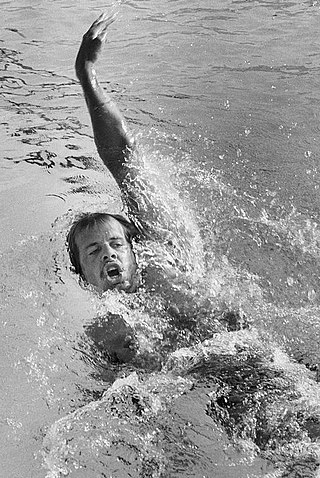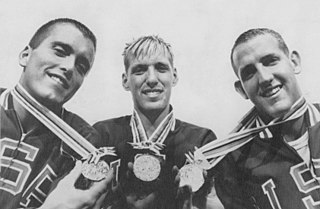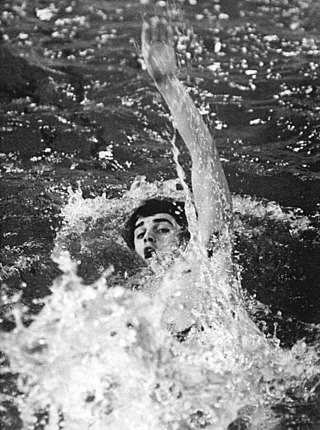
The men's 200 metre backstroke event for the 1976 Summer Olympics was held in Montreal. The event took place on 24 July. There were 33 competitors from 23 nations, with each nation having up to 3 swimmers. The event was won by John Naber of the United States in world-record time; he was the first person to swim the event in under 2 minutes (1:59.19). It was Naber's fifth medal of the Games: completing a double in the backstroke events as well as golds in the medley relay and the 4×200 free relay, along with a silver in the 200 free. It was the second American victory and second American medal sweep in the men's 200 metre backstroke, after 1968; of the 12 medals from 1968 through 1976, 10 were won by Americans and the other two by Roland Matthes. Peter Rocca (silver) and Dan Harrigan (bronze) were the other two Americans, along with Naber, to reach the podium in 1976. The rules changed in 1984 to limit nations to two swimmers each, preventing further sweeps.
The men's 100 metre backstroke event at the 1952 Olympic Games took place between 30 July and 1 August, at the Swimming Stadium. This swimming event used the backstroke. Because an Olympic size swimming pool is 50 metres long, this race consisted of two lengths of the pool.
The women's 100 metre freestyle event at the 1952 Olympic Games took place between 26 and 28 July at the Swimming Stadium. This swimming event used freestyle swimming, which means that the method of the stroke is not regulated. Nearly all swimmers use the front crawl or a variant of that stroke. Because an Olympic size swimming pool is 50 metres long, this race consisted of two lengths of the pool.
The women's 100 metre backstroke event at the 1952 Olympic Games took place on 29–31 July at the Swimming Stadium. This swimming event used the backstroke. Because an Olympic-size swimming pool is 50 metres long, this race consisted of two lengths of the pool.
The women's 100 metre backstroke event at the 1956 Olympic Games took place on 5 December. This swimming event used backstroke. Twenty-three swimmers from 14 countries competed in this swimming event. Because an Olympic-size swimming pool is 50 metres long, this race consisted of two lengths of the pool. This was the seventh time that there had been the women's 100-metre backstroke after its debut in the 1924 Paris Olympics.

The men's 100 metre backstroke event at the 1960 Olympic Games took place between August 30 and 31. This swimming event used backstroke. Because an Olympic-size swimming pool is 50 metres long, this race consisted of two lengths of the pool.
The women's 100 metre freestyle event at the 1960 Olympic Games took place between August 26 and 29. This swimming event used freestyle swimming, which means that the method of the stroke is not regulated. Nearly all swimmers use the front crawl or a variant of that stroke. Because an Olympic-size swimming pool is 50 metres long, this race consisted of two lengths of the pool.
The women's 400 metre freestyle event at the 1960 Olympic Games took place between August 31 and September 1. This swimming event used freestyle swimming, which means that the method of the stroke is not regulated. Nearly all swimmers use the front crawl or a variant of that stroke. Because an Olympic size swimming pool is 50 metres long, this race consisted of eight lengths of the pool.
The women's 4 × 100 metre medley relay event at the 1960 Olympic Games took place on August 30 (qualification) and September 2 (final). This swimming event uses medley swimming as a relay. Because an Olympic size swimming pool is 50 metres long, each of the four swimmers completed two lengths of the pool, each using a different stroke. The first on each team used the backstroke, the second used the breaststroke, the third used the butterfly stroke, and the final swimmer used freestyle.

The men's 200 metre backstroke event at the 1964 Summer Olympics took place between October 11 and 13. There were 34 competitors from 21 nations, with each nation having up to 3 swimmers. The medals were swept by the United States, with Jed Graef, Gary Dilley, and Bob Bennett taking gold, silver, and bronze respectively.
The women's 100 metre freestyle event at the 1964 Olympic Games took place between October 12 and 13. This swimming event used freestyle swimming, which means that the method of the stroke is not regulated. Nearly all swimmers use the front crawl or a variant of that stroke. Because an Olympic-size swimming pool is 50 metres long, this race consisted of two lengths of the pool.
The women's 100 metre backstroke event at the 1964 Olympic Games took place between October 13 and 14. This swimming event used backstroke. Because an Olympic-size swimming pool is 50 metres long, this race consisted of two lengths of the pool.
The men's 100 metre backstroke event at the 1968 Olympic Games took place between 21 and 22 October. This swimming event used backstroke. Because an Olympic-size swimming pool is 50 metres long, this race consisted of two lengths of the pool.
The women's 100 metre freestyle event at the 1968 Olympic Games took place between 18 and 19 October. This swimming event used freestyle swimming, which means that the method of the stroke is not regulated. Nearly all swimmers use the front crawl or a variant of that stroke. Because an Olympic-size swimming pool is 50 metres long, this race consisted of two lengths of the pool.
The women's 100 metre backstroke event at the 1968 Olympic Games took place between 22 and 23 October. This swimming event used backstroke. Because an Olympic-size swimming pool is 50 metres long, this race consisted of two lengths of the pool.
The women's 200 metre backstroke event at the 1968 Olympic Games took place 25 October. This swimming event used backstroke. Because an Olympic size swimming pool is 50 metres long, this race consisted of four lengths of the pool. This was the first appearance for this event in the Olympics for the women swimmers.
The men's 100 metre backstroke event at the 1972 Olympic Games took place between August 28 and 29. This swimming event used backstroke. Because an Olympic-size swimming pool is 50 metres long, this race consisted of two lengths of the pool.

The men's 200 metre backstroke event at the 1972 Summer Olympics took place on September 2 at the Olympia Schwimmhalle. There were 36 competitors from 23 nations, with each nation having up to 3 swimmers. The podium was very similar to the previous Games in 1968, with Roland Matthes of East Germany winning gold and the United States taking the other two medals, including one going to Mitch Ivey. Matthes and Ivey were the first two men to earn multiple medals in the event, with Matthes the first to win back-to-back championships and Ivey adding his 1972 bronze to his 1968 silver. Mike Stamm was the silver medalist in Munich. Matthes also defended his 1968 100 metre backstroke title, giving him the backstroke double a second time.
The women's 100 metre freestyle event at the 1972 Olympic Games took place between August 28 and 29. This swimming event used freestyle swimming, which means that the method of the stroke is not regulated. Nearly all swimmers use the front crawl or a variant of that stroke. Because an Olympic size swimming pool is 50 metres long, this race consisted of two lengths of the pool.
The women's 100 metre backstroke event at the 1972 Olympic Games took place between September 1 and 2. This swimming event used backstroke. Because an Olympic-size swimming pool is 50 metres long, this race consisted of two lengths of the pool.




